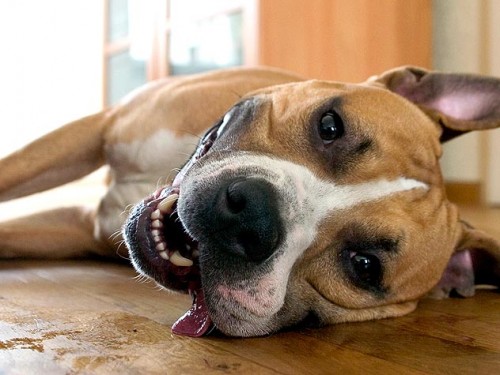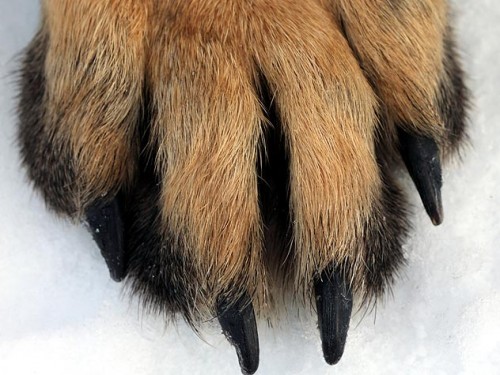How to Brush Your Pet’s Teeth
When should you brush?
The best time to brush your pet’s teeth is when you are both relaxed. If your pet growls, bites, scratches or shows any other signs of aggression during the procedure, stop immediately and consult your Banfield doctor for advice.

Step 1
Gently position your dog in a corner (of a sofa, chair or room) so that he will be secure and more easily handled. Carefully lift the lips to expose his teeth.
Step 2
Rub your finger over the dog’s teeth and gums for about 15 seconds to get the dog used to having something in his mouth. It might be necessary to do this a couple of times before the next step.
Step 3
Put a small amount of toothpaste specially formulated for pets on your finger, and allow the pet to taste it.
Step 4
Slide a finger brush onto your index finger and put a small amount of toothpaste on the brush. Gently rub the brush over your dog’s teeth and gums. Repeat this process for the next few brushing session. Because finger brushes are not as effective as regular toothbrushes, the pet should be transitioned to a regular bristled toothbrush as soon as the pet is comfortable with it.
Step 5
Apply a small amount of toothpaste to a bristle brush specially designed for pets. Place the brush bristles at a 45-degree angle to the gum line. Move the brush gently in circular patterns over the dog’s teeth. Start by brushing a few teeth. As brushing sessions continue, slowly include more teeth. Build up to about 30 seconds on each side of the dog’s mouth. Remember to brush both upper and lower teeth.
Caring for Your Pup’s Paws in the Winter
Winter can be a tough time for a dog’s paws. Prevent weather-related paw pad injuries by following some basic tips and the use of products designed for paw protection.
Preventing Paw Pad Injuries

Another threat from deicers is ingestion. Dogs may lick their paws or your boots and ingest deicing salts. To prevent your dog from ingesting deicing salts, keep a shallow bowl of warm water and a cloth near the entryway to your home so that you can wipe your boots and your dog’s paws when coming back inside.
Another common cause of sore paws during the cold winter months are the ice balls which form between the pads and toes of hairy-footed dog. To reduce the risk of ice balls, keep inter-pad hair trimmed neatly and short during the winter months. Not only can hairy feet contribute to the development of ice balls on the feet, paw hair can retain a lot of those nasty deicing salts. If your dog has hairy feet, trim them throughout the winter.
Dogs left in the cold for long periods of times are also at risk for frostbite on paws and hypothermia. It is not advised that dogs spend hours in the cold. In winter, frequent short walks are better for your dog than a single long walk
Bag Balm, a product available at nearly every pharmacy, applied in a thin layer daily or every other day should help keep your dog’s paws from cracking and bleeding. Keeping a humidifier in the house should also prevent dry, itchy skin for both you and your pet.
Products For Protecting Dog Paws
There are many products designed to protect dog paw pads during the winter month, from pet safe deicing products to protective waxes and dog booties. Safe Paw is a common pet-friendly deicer, but sand, small stones, and kitty litter (non-clumping) are also options for deicing while protecting your dog’s pads from injury and chemical burns. Musher’s Secret is one of the most popular paw waxes. Paw wax is applied to the pads of the feet before a walk, forming a protective barrier between the paw and the salty sidewalk or pavement. Paw wax will wear away after extended exercise, and should be reapplied before each walk.
The best protection for your dog’s paws and pads are dog booties. Just as wearing boots in the winter protects your pads, dog booties will prevent injury to your dog’s feet. Dog boots can protect your dog’s paws from salt, ice balls, and cutting his pads on sharp items that may be hidden under the snow or sharp ice. Proper sizing of dog booties is especially important in ensuring that the booties are comfortable for your dog to wear and maximize paw protection.
Dog booties may look silly, but really are the ultimate protection for your dog. Human snowsuits look silly also, but are they not the best for keeping sledding kids warm? Just as your kid may not want to wear a snowsuit, your dog may not initially like wearing booties. With a little time and patience, you can train your dog to love wearing his dog boots!
Instructions on Grooming Dog Paws
1Inspect your dog’s paws weekly. Look for signs of dryness or cracking in the pads, torn or overgrown nails, and minor cuts anywhere in the paw. Check for small objects that might be lodged between pads. Use tweezers to remove anything you find. Praise your dog during an inspection to send the message that paw handling is a good thing.
2Trim the fur around the paws. When long paw fur becomes matted it can hide irritating objects such as small stones and soot. Matted fur itself becomes an irritant when it cakes and hardens. Remove this fur carefully with scissors, clipping in small snips rather than cutting large chunks of hair at a time.
3Examine nails and trim as needed. Clip after a bath, when nails will be softer, and use a trimmer designed for dog nails. Take care not to trim too short, as dog nails contain a small vein, called a quick, and clipping too close to the quick can cause bleeding and pain.
4Massage Vitamin E oil or paw wax into your dog’s pads to keep them soft and prevent drying and cracking, which can be very painful. If using Vitamin E, poke a hole in a few capsules and squeeze out as much oil as needed to massage into pads. Paw wax, which can be purchased online or at pet shops, protects pads from rock salt in winter and hot pavement in summer by forming a protective barrier.
5Watch for paw licking or chewing, which can be triggered by allergies or irritants. Keep your dog away from lawn chemicals and any known allergens, including ragweed or plants in your yard, to help maintain paw health. If a dog’s paw licking becomes obsessive, seek veterinary care to determine the cause and develop a treatment.
6Handle your dog’s paws while playing or petting so the animal becomes accustomed to you touching the paws when you’re not grooming. This should be easy to do with puppies, but older dogs that are not used to being paw handled may protest. Work gently to convince an uncomfortable dog that your handling of its paws can be a time of bonding.





